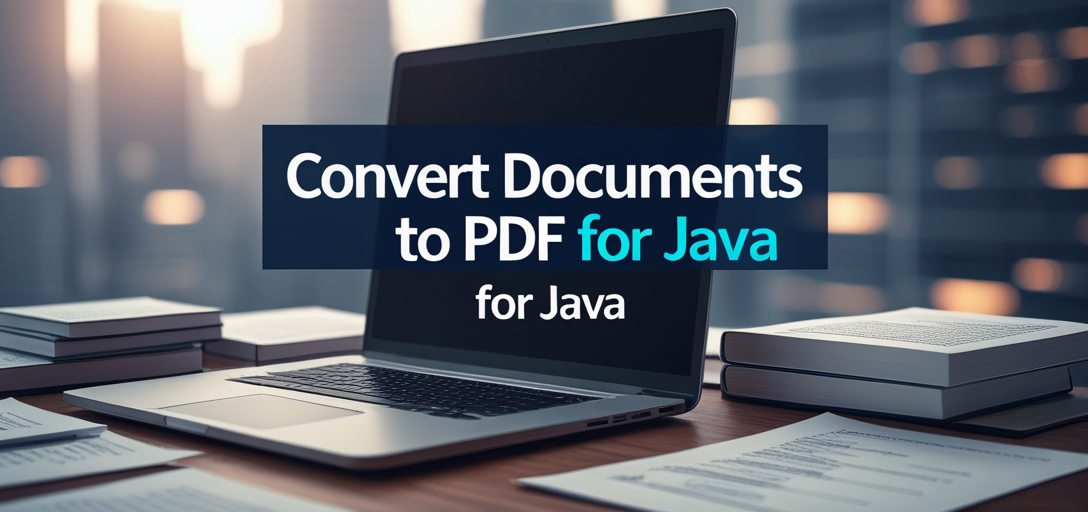How to Convert Documents to PDF Using GroupDocs.Viewer for Java
Introduction
In today’s digital world, ensuring that documents are consistently accessible as PDFs is invaluable for compatibility and security across platforms. This comprehensive guide will show you how to convert any document into a PDF format using the powerful GroupDocs.Viewer for Java library. Master this process to enhance your document management capabilities.

What You’ll Learn:
- How to set up GroupDocs.Viewer in your Java project
- Steps involved in converting documents to PDF
- Customizing the conversion with options and configurations
Let’s ensure you have everything ready to start using this exciting feature.
Prerequisites
Before diving into the code, make sure you have the following:
Required Libraries:
- GroupDocs.Viewer for Java (Version 25.2)
Environment Setup Requirements:
- Java Development Kit (JDK) installed on your machine
- A suitable IDE such as IntelliJ IDEA or Eclipse
Knowledge Prerequisites:
- Basic understanding of Java programming
- Familiarity with Maven for dependency management
With these prerequisites in place, you’re ready to begin.
Setting Up GroupDocs.Viewer for Java
To start using GroupDocs.Viewer for Java, ensure your project is correctly configured. Follow these steps if you’re using Maven:
Maven Configuration
Add the following repository and dependency to your pom.xml file:
<repositories>
<repository>
<id>repository.groupdocs.com</id>
<name>GroupDocs Repository</name>
<url>https://releases.groupdocs.com/viewer/java/</url>
</repository>
</repositories>
<dependencies>
<dependency>
<groupId>com.groupdocs</groupId>
<artifactId>groupdocs-viewer</artifactId>
<version>25.2</version>
</dependency>
</dependencies>
License Acquisition
- Free Trial: Start with a free trial to explore features.
- Temporary License: Obtain a temporary license for full access during evaluation.
- Purchase: For long-term usage, purchase a commercial license.
Initialization and Setup
To initialize GroupDocs.Viewer in your Java application, follow these steps:
import com.groupdocs.viewer.Viewer;
public class ViewerSetup {
public static void main(String[] args) {
try (Viewer viewer = new Viewer("path/to/your/document")) {
// Your conversion code will go here.
} catch (IOException e) {
System.out.println("Error initializing GroupDocs.Viewer: " + e.getMessage());
}
}
}
This setup is crucial for accessing all of the powerful features that GroupDocs.Viewer offers.
Implementation Guide
Now, let’s dive into converting your documents to PDF using GroupDocs.Viewer. We’ll break this down into manageable steps:
Convert Document to PDF
Overview
In this section, we will convert a document from any supported format (e.g., DOCX) into a PDF file.
1. Initialize the Viewer with Your Document
Start by creating an instance of Viewer and providing it the path to your document:
try (Viewer viewer = new Viewer("YOUR_DOCUMENT_DIRECTORY/SAMPLE_DOCX")) {
// Further processing will be done here.
}
2. Set Up PDF View Options
Next, configure the PdfViewOptions using a custom file stream factory. This allows you to control how the output is managed:
MemoryFileStreamFactory streamFactory = new MemoryFileStreamFactory();
PdfViewOptions options = new PdfViewOptions(streamFactory);
3. Render the Document to PDF Format
Use the view() method on your Viewer instance to perform the conversion:
viewer.view(options);
4. Obtain and Use the Resulting PDF Stream
Finally, extract the resulting PDF as an input stream for further use or storage:
InputStream pdfStream = streamFactory.getStream();
pdfStream.close(); // Always remember to close streams after usage.
Troubleshooting Tips
- Ensure all file paths are correct and accessible.
- Verify your GroupDocs.Viewer version is up-to-date.
Practical Applications
Here are some real-world applications of converting documents to PDF using GroupDocs.Viewer:
- Document Archiving: Maintain consistent document formats for archival purposes.
- Web Publishing: Convert articles or reports into web-friendly PDFs.
- Data Security: Enhance document security by distributing them in a less editable format.
Integration with systems like content management platforms can further expand your capabilities.
Performance Considerations
When working with GroupDocs.Viewer, consider these performance optimization tips:
- Utilize memory efficiently by closing streams promptly after use.
- Profile and monitor resource usage to ensure smooth operation, especially for large documents.
Adhering to best practices in Java memory management will enhance your application’s efficiency.
Conclusion
You’ve now learned how to convert documents into PDFs using GroupDocs.Viewer for Java. This powerful tool not only simplifies document management but also opens up a myriad of possibilities for application integration and data handling.
Next Steps:
- Explore additional features of GroupDocs.Viewer.
- Integrate your solution with other systems or frameworks.
Take the leap and start converting documents today!
FAQ Section
Q: How do I set up GroupDocs.Viewer in my Java project?
A: Add the Maven dependency to your pom.xml as shown above, and configure your environment with a valid license.
Q: Can I convert any document format using GroupDocs.Viewer? A: Yes, GroupDocs.Viewer supports multiple formats. Check their documentation for specifics.
Q: What should I do if the conversion fails? A: Verify file paths, ensure dependencies are correctly set up, and check your GroupDocs.Viewer version.
Q: How can I handle large documents efficiently? A: Manage memory by closing streams after use and monitor performance through profiling tools.
Q: Where can I get support for GroupDocs.Viewer? A: Visit the GroupDocs Support Forum for assistance.
Resources
- Documentation: GroupDocs Viewer Java Documentation
- API Reference: GroupDocs API Reference
- Download GroupDocs.Viewer: Java Releases
- Purchase License: Buy Now
- Free Trial: Start a Free Trial
- Temporary License: Get Temporary Access
Embark on your journey to mastering document conversion with GroupDocs.Viewer and explore the full potential of Java PDF Conversion!